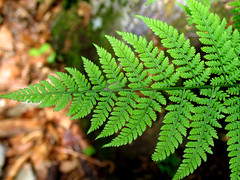 0
comments
Thursday, August 30, 2007
0
comments
Thursday, August 30, 2007

Sword Fern. Photo taken near middle fork snoqualmie river, WA.
Although the above sword fern may look and act almost exactly like another in nearby Oregon it has hints of once being on the track to becoming a different species. A paper by Soltis et al. (1996) looked at chloroplast DNA of the sword fern, among other plants, and found that there is a significant difference between populations in the north (Alaska to central Oregon) and populations in the south (central Oregon to northern California).
Genetic isolation of a once uniform population does not occur easily. For two populations to emerge from one there must be some sort of isolating mechanism that prevents the exchange of genetic material. Isolation allows the two populations to diverge genetically through genetic drift and selection without sharing the changes.
Soltis et al. (1996) suggested that the isolating mechanism was extensive glaciation which occurred in the Pleistocene (the famous Ice Age). Because plants have an extremely difficult time growing on moving rivers of ice the sword fern population was cleaved and left with, at least, one northern refugium and one southern refugium. The two populations were left to go about their own business and respond to their own local environment.
Today the glaciers are mostly gone and the northern and southern populations are allowed to fill the gap. Genetic material is being transferred between the two and the differences will most likely blur but there will always be the hint of what once could have been a new and noble species.
Sources
Soltis, D., Gitzendanner, M., Strenge, D., Soltis, P. (1996) Chloroplast DNA intraspecific phylogeography of plants from the Pacific Northwest of North America. Plant Systematics and Evolution (206) 353-373. http://www.springerlink.com/content/v15m72k6238462p3/

